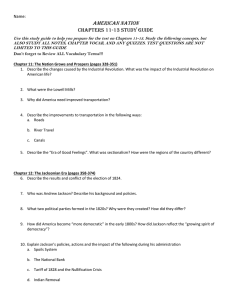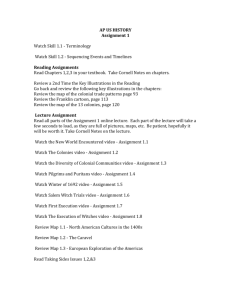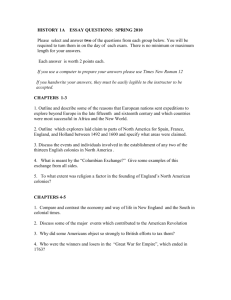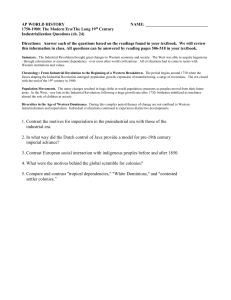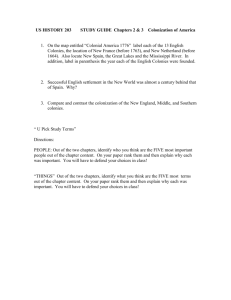MADISON PUBLIC SCHOOL DISTRICT United States History I Honors Authored by
advertisement
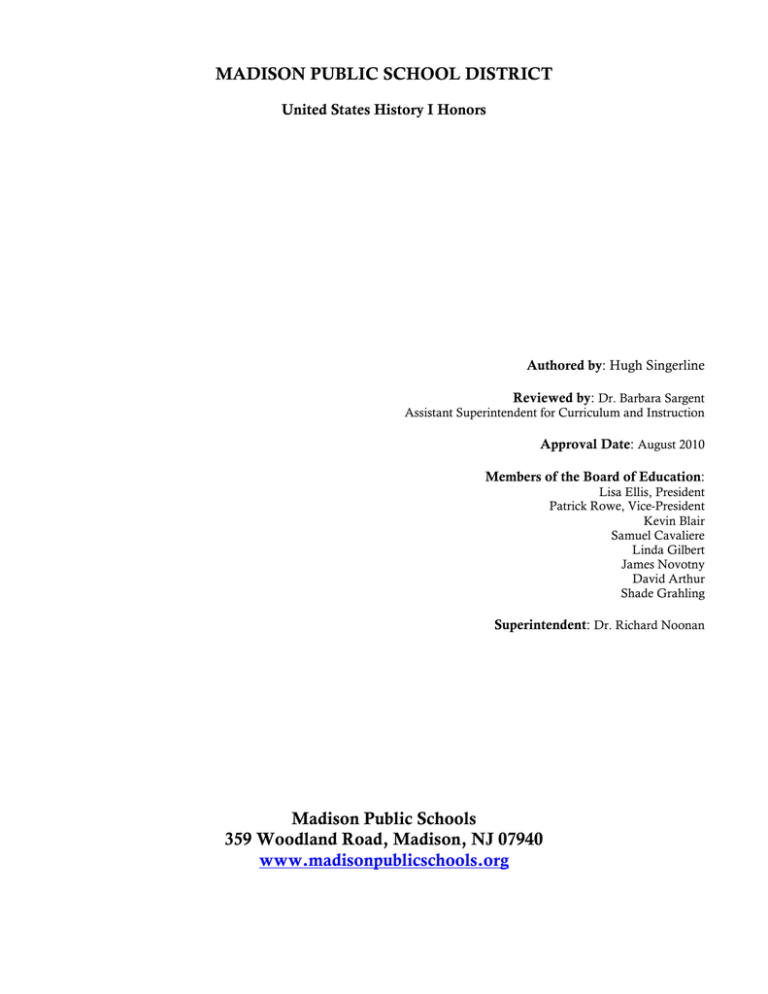
MADISON PUBLIC SCHOOL DISTRICT United States History I Honors Authored by: Hugh Singerline Reviewed by: Dr. Barbara Sargent Assistant Superintendent for Curriculum and Instruction Approval Date: August 2010 Members of the Board of Education: Lisa Ellis, President Patrick Rowe, Vice-President Kevin Blair Samuel Cavaliere Linda Gilbert James Novotny David Arthur Shade Grahling Superintendent: Dr. Richard Noonan Madison Public Schools 359 Woodland Road, Madison, NJ 07940 www.madisonpublicschools.org I. OVERVIEW This 10th grade social studies curriculum focuses on the earlier periods in American history, beginning with the arrival of the English and their settlements of Jamestown and Plymouth/Massachusetts Bay, and ending with the post-Civil War period of Reconstruction as well as a second look at the West. Intended to encourage students to develop their research, analytical, critical thinking, and communication skills, the course employs a traditional chronological approach in order to prepare students for the Advanced Placement Exam which they would take during their junior year. That said, this course will also make occasional use of thematic strands as focus prompts for deeper investigation into the complex issues found in American history. Students in this US I Honors class will be prepared for US II Honors, which is also the Advanced Placement class for US History. Honors students are challenged in every aspect of their studies: reading assignments, thinking skills, writing assignments, research, and class discussions. Strong motivation, independent study, attention to deadlines, and ability to read challenging text are keys to success in this course. II. RATIONALE The United States History I Honors curriculum is meant to encourage the further development of existing skills as well as increase student mastery and retention of historical knowledge, with the larger purpose of enabling students to better participate as global citizens in a nation that has evolved over the course of time. Successful completion of this course will allow for greater awareness of the culture, economics, politics, culture, and ideas of the United States, and provide a solid foundation for the Advanced Placement United States History course and the Advanced Placement Exam. III. STUDENT OUTCOMES (Core Curriculum Standards) Standard 6.1 (U.S. History: America in the World). All students will acquire the knowledge and skills to think analytically about how past and present interactions of people, cultures, and the environment shape the American heritage. Such knowledge and skills enable students to make informed decisions that reflect fundamental rights and core democratic values as productive citizens in local, national, and global communities. Students will: Unit 1: America in the British Empire/Colonial Society • Explain how British North American colonies adapted the British governance structure to fit their ideas of individual rights, economic growth, and participatory government. • Relate regional geographic variations (e.g., climate, soil conditions, and other natural resources) to economic development in the New World. • Explain how economic ideas and the practices of mercantilism and capitalism conflicted during this time period. • Determine the extent to which natural resources, labor systems (i.e., the use of indentured servants, African slaves, and immigrant labor), and entrepreneurship contributed to economic development in the American colonies. Unit 2: Road to Revolution • Analyze the intellectual origins of the major ideas expressed in the Declaration of Independence • Analyze contributions and perspectives of African Americans, Native Americans, and women during the American Revolution. Unit 3: Articles of Confederation/Constitution • • • • Evaluate the importance of the Declaration of Independence, the Constitution, and the Bill of Rights to the spread of democracy around the world. Compare and contrast state constitutions, including New Jersey’s 1776 constitution, with the United States Constitution, and determine their impact on the development of American constitutional government. Compare and contrast the arguments of Federalists and Anti-Federalists during the ratification debates, and assess their continuing relevance. Analyze the problems of financing the American Revolutionary War and dealing with wartime inflation and profiteering. Unit 4: New Nation • Explain how judicial review made the Supreme Court an influential branch of government, and assess the continuing impact of the Supreme Court today. • Examine the emergence of early political parties and their views on centralized government and foreign affairs, and compare these positions with those of today’s political parties. • Explain the effects of inflation, debt, and attempts by new state and national governments to rebuild the economy by addressing issues of foreign and internal trade, banking, and taxation. • Relate events in Europe to the development of American trade and American foreign and domestic policies. • Describe how the Supreme Court increased the power of the national government and promoted national economic growth during this era. Unit 5: Jacksonian Era • Analyze how the United States has attempted to account for regional differences while also striving to create an American identity. • Judge the fairness of government treaties, policies, and actions that resulted in Native American migration and removal. • Compare and contrast the successes and failures of political (i.e., the 1844 State Constitution) and social (i.e., abolition, women’s rights, and temperance) reform movements in New Jersey and the nation during the Antebellum period. • Analyze how technological developments transformed the economy, created international markets, and affected the environment in New Jersey and the nation. • Analyze the role education played in improving economic opportunities and in the development of responsible citizens. • Determine the impact of religious and social movements on the development of American culture, literature, and art. • Analyze how ideas found in key documents (i.e., the Declaration of Independence, the Seneca Falls Declaration of Sentiments and Resolution, the Emancipation Proclamation, and the Gettysburg Address) contributed to demanding equality for all. Unit 6: Antebellum America • Assess the influence of Manifest Destiny on foreign policy during different time periods in American history. • Assess the role of geopolitics in the development of American foreign relations during this period. • Analyze the various rationales provided as a justification for slavery. • Assess the impact of Western settlement on the expansion of United States political boundaries. • Assess how states' rights (i.e., Nullification) and sectional interests influenced party politics and shaped national policies (i.e., the Missouri Compromise and the Compromise of 1850). • Analyze the ways in which prevailing attitudes, socioeconomic factors, and government actions (i.e., the Fugitive Slave Act and Dred Scott Decision) in the North and South (i.e., Secession) led to the Civil War. Unit 7: Civil War and Reconstruction • Evaluate how political and military leadership affected the outcome of the Civil War. • Judge the effectiveness of the 13th, 14th, and 15th Amendments in obtaining citizenship and equality for African Americans. • Use maps and primary sources to assess the impact that geography, improved military strategies, and new modes of transportation had on the outcome of the Civil War. • Assess the role that economics played in enabling the North and South to wage war. • Compare and contrast the immediate and long-term effects of the Civil War on the economies of the North and South. • Compare and contrast the roles of African Americans who lived in Union and Confederate states during the Civil War. • Analyze the debate about how to reunite the country, and determine the extent to which enacted Reconstruction policies achieved their goals. • Relate conflicting political, economic, social, and sectional perspectives on Reconstruction to the resistance of some Southern individuals and states. • Analyze the impact of the Civil War and the 14th Amendment on the development of the country and on the relationship between the national and state governments. Unit 8: The West • Determine how expansion created opportunities for some and hardships for others by considering multiple perspectives. • Analyze the impact of population shifts and migration patterns during the Reconstruction period. • Explain how the Homestead Act, the availability of land and natural resources, and the development of transcontinental railroads and waterways promoted the growth of a nationwide economy and the movement of populations. • Compare and contrast economic development of the North, South, and West in the post-Civil War period. IV. ESSENTIAL QUESTIONS AND CONTENT Unit 1: America in the British Empire/Colonial Society (Jamestown through the French and Indian War, 1607-1763) • In what ways did geographic and climatic diversity affect regional development among the North American colonies of Great Britain? • How did the system of indentured servitude and the enslavement of Africans contribute to the economic and socio-cultural development of early America? • To what extent did the ideas and practices of mercantilism define economic relations between Great Britain and its North American colonies? • How significant was the impact of other European powers and their colonies on the political and economic development of Colonial America? • How did the tension between established religion and religious tolerance play out in the Colonial period? • How did the availability of land as well as the general remoteness of the British colonies affect Colonial efforts to recreate British social relationships in the North American environment? Unit 2: Road to Revolution (French and Indian War through the American Revolution, 1754-1783) • How successfully did a new American identity develop in the context of economic diversity and in light of already existing attachments to individual colonies? • • • • To what extent did economic considerations influence the eventual rift between Great Britain and the American Colonies? Why might it be argued that British success in the French and Indian War led to the eventual loss of its North American colonies? How did the American colonists use political institutions and democratic practices to resist British authority in the period leading up to the American Revolution? How “revolutionary” was the American Revolution? Unit 3: Founding Era (Articles of Confederation/Constitution, 1781-1791) • How responsible were economic developments in post-revolutionary America in contributing to political instability and the formation of a new constitutional order? • In what ways did the adherence to republican ideals and individual rights affect the evolution of American government in terms of the distribution of political power? • To what extent did revolutionary ideology impact the rights of women and minority groups in the early republic? Unit 4: New Nation (Washington Administration Through the War of 1812, 1789-1815) • To what extent were competing visions of American economic development the driving force behind not only the American economy, but also governmental policies and socio-cultural changes? • Could American foreign policy in dealing with the international challenges presented by the Napoleonic era be considered successful? • How significant was actual government practice in shaping our understanding of the Constitution and the power of American political institutions? Unit 5: Jacksonian Era (Era of Good Feelings through Jacksonian Democracy, 1815-1840s) • To what extent did members of minority groups (African-Americans, women and Native Americans) share in the benefits afforded the "common man" during the Jacksonian era? • How did the rise of industrialization play out in the tension between a self-sufficient national economy and regional economic competition? • In what ways did political developments during the Jacksonian era affect the American constitutional and electoral systems? • How effective were reform movements during the Jacksonian era in dealing with the emerging social and economic problems of the early industrial era? Unit 6: Antebellum America (Industrial and Transportation Revolutions to the Civil War, 1820s-1860) • To what extent was westward expansion the result of technological and transportation innovations? • How did the concept of Manifest Destiny impact relations with neighboring powers and indigenous populations? • Was America a “land of immigrants” prior to the Civil War? • How was westward expansion involved in the constitutional issue of slavery? • At what point did political, economic, and philosophical polarization on the slavery question become a “point of no return”? Unit 7: Civil War and Reconstruction (Election of Lincoln to the Election of Hayes, 1860-1877) • How did demographics and economic and technological conditions play out in the conduct and outcome of the Civil War? • In what ways did the Civil War and Reconstruction affect the constitutional and political systems of the United States? • To what degree was Reconstruction successful with regard to the rights and social standing of AfricanAmericans? Unit 8: The West (Homestead Act and Transcontinental Railroad to Frederick Jackson Turner, 1862-1890s) • To what extent has the “myth of the West” been based in the late-nineteenth century reality of that region? • How did the West contribute to the development of an emerging national economy? • Could the West be accurately seen as a zone of opportunity for members of minority groups? • In what ways did the West affect social relationships in terms of gender and race, as well as political relationships in terms of citizen participation? V. STRATEGIES The US History I Honors curriculum will employ a traditional “survey” approach in order to introduce students to the breadth of material to be covered in the Advanced Placement Exam, but in conjunction with occasional efforts at depth in which topics of enduring interest will be pursued thematically and in greater detail through a variety of methods, including: • • • • • • • • • Teacher presentation Film Guided reading Student research projects Primary source analysis Role play simulation Individual and group presentations Class discussion Geographic analysis Particular emphasis will be given to reading, interpreting and analyzing a variety of primary source materials, structured to enable students to read comprehensively, communicate analytically, and think systematically about how the past interactions of individuals and groups have shaped the American experience. Assuming previous experience and self-motivation in Honors-level students, this course will concentrate on the practice and improvement of existing skills. VI. EVALUATION The goals of evaluation are to check on students’ grasp of historical knowledge and their ability to interpret and judge sources of information, as well as to more narrowly prepare students for the Advanced Placement Exam, which most of these students will take as juniors during the US II Honors course. Students will be assessed through a variety of measures, including: ▪ ▪ ▪ ▪ ▪ ▪ ▪ Quizzes Student Presentations DBQ (document-based question)-style responses to prompts Reading checks Research reviews Homework Essays VII. REQUIRED RESOURCES Textbooks: Blum, The National Experience (1993); and Nash, The American People (1994) Teacher will supplement the assigned textbooks with a variety of materials such as PowerPoint presentations, primary and secondary sources, film and video clips, educational websites and media center databases. Supplementary Materials: (Representative Listing) PowerPoint Presentations found on www.historyteacher.net Online streaming videos at: www.pbs.org and www.cjims.org Supreme Court Cases http://www.streetlaw.org/en/landmark.aspx Digital History http://www.digitalhistory.uh.edu/timeline/timelineN.cfm Original Documents and Primary Sources http://avalon.law.yale.edu/ http://www.gilderlehrman.org/ Excerpts of the following films may be shown to enhance student understanding of the material: • "The Last of the Mohicans" (Unit 1) • "Roots" (Units 4-6) • "Amistad" (Unit 5) • "Glory" (Unit 7) • "Birth of a Nation (Unit 7) • "Dances With Wolves" (Unit 8) • "Shane" (Unit 8) • "Red River" (Unit 8) VIII. SCOPE AND SEQUENCE (Note: This section should be taken as a representative listing in that it seeks to highlight material of greater weight rather than all material to be covered in the course. Similarly, chapter references are intended as a general guide to where information relevant to this material can be located). Unit 0: Exploration and Early European Colonization (Voyage of Columbus to First Permanent English Settlements, 1492-1607) -- 2 Weeks Blum, Chapter 1; Nash, Chapters 1-2 • Indigenous peoples and their societies • European contacts with Native Americans • Spanish empire in the New World • French colonization in Canada Unit 1: America in the British Empire/Colonial Society (Jamestown through the French and Indian War, 1607-1763) -- 4 Weeks Blum, Chapters 1-4; Nash, Chapters 2-5 • • • • • • • • • English settlement of New England, the Mid-Atlantic region, and the South From indentured servitude to slavery in the Chesapeake region Religious diversity in the American colonies Resistance to Colonial authority (Bacon’s Rebellion, the Glorious Revolution) Transatlantic trade Growth of plantation economies and slave societies The Enlightenment and the Great Awakening Colonial governments and imperial policy in British North America French and Indian War Unit 2: Road to Revolution (French and Indian War through the American Revolution, 1754-1783) -- 4 Weeks Blum, Chapters 4-5; Nash, Chapters 5-6 • The Imperial Crisis and resistance to Britain • War for Independence • The development of an American identity and republican ideals Unit 3: Founding Era (Articles of Confederation/Constitution, 1781-1791) -- 5 Weeks Blum, Chapter 5; Nash, Chapter 7 • State constitutions and the Articles of Confederation • Post-Revolution economy/Shays' Rebellion • The federal Constitution Unit 4: New Nation (Washington Administration Through the War of 1812, 1789-1815) -- 4 Weeks Blum, Chapters 6-7; Nash, Chapters 8-9 • Washington, Hamilton, and shaping of the national government • Emergence of political parties (Federalists and Republicans) • Republican Motherhood and education for women • Significance of Jefferson’s presidency • Expansion into the trans-Appalachian West • Growth of slavery and free Black communities • War of 1812 and its consequences MIDTERM EXAM Unit 5: Jacksonian Era (Era of Good Feelings through Jacksonian Democracy, 1815-1840s) -- 5 Weeks Blum, Chapters 8-10; Nash, Chapters 10-12 • Beginnings of industrialization and changes in social and class structures • Emergence of the second party system • Federal authority and its opponents (judicial Federalism, the Bank War, tariff controversy, and state’s rights debates) • Jacksonian democracy and its successes and limitations • Forced removal of Native Americans to the trans-Mississippi West Unit 6: Antebellum America (Industrial and Transportation Revolutions to the Civil War, 1820s-1860) -- 5 Weeks Blum, Chapters 10-13; Nash, Chapters 11, 13-14 • The transportation revolution and creation of a national market economy • Immigration and nativist reaction • Planters, yeoman farmers, and slaves in the cotton South • Evangelical Protestant revivalism • Social reforms • Ideals of domesticity • Transcendentalism and utopian communities • American Renaissance (literary and artistic expressions) • Western migration and cultural interactions • Territorial acquisitions • Early American imperialism (the Mexican War) • Pro- and anti-slavery arguments and conflicts • Compromise of 1850 and popular sovereignty • Kansas-Nebraska Act and the emergence of the Republican Party Unit 7: Civil War and Reconstruction (Election of Lincoln to the Election of Hayes, 1860-1877) -- 5 Weeks Blum, Chapters 14-16; Nash, Chapters 15-17 • Abraham Lincoln, the Election of 1860, and secession • Two societies at war (mobilization, resources, and internal dissent) • Military strategies and foreign diplomacy • Emancipation and the role of African Americans in the War • Social, political, and economic effects of war in the North, South, and West • Presidential and Radical Reconstruction • Southern state governments (aspirations, achievements, failures) • Role of African Americans in politics, education, and the economy • Compromise of 1877 • Impact of Reconstruction • Reconfiguration of southern agriculture (sharecropping and crop-lien system) • The politics of segregation (Jim Crow and disenfranchisement) Unit 8: The West (Homestead Act and Transcontinental Railroad to Frederick Jackson Turner, 1862-1890s) -4 Weeks Blum, Chapter17-18, 20; Nash, Chapter 17 • Expansion and development of western railroads • Competitors for the West (miners, ranchers, homesteaders, and Native Americans) • Government policy toward Native Americans • Gender, race, and ethnicity in the far West • Environmental impacts of western settlement • Turner’s Frontier Thesis FINAL EXAM
